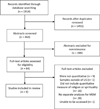Religion and Spirituality's Influences on HIV Syndemics Among MSM: A Systematic Review and Conceptual Model
- PMID: 26319130
- PMCID: PMC4755900
- DOI: 10.1007/s10461-015-1173-0
Religion and Spirituality's Influences on HIV Syndemics Among MSM: A Systematic Review and Conceptual Model
Abstract
This paper presents a systematic review of the quantitative HIV research that assessed the relationships between religion, spirituality, HIV syndemics, and individual HIV syndemics-related health conditions (e.g. depression, substance abuse, HIV risk) among men who have sex with men (MSM) in the United States. No quantitative studies were found that assessed the relationships between HIV syndemics, religion, and spirituality. Nine studies, with 13 statistical analyses, were found that examined the relationships between individual HIV syndemics-related health conditions, religion, and spirituality. Among the 13 analyses, religion and spirituality were found to have mixed relationships with HIV syndemics-related health conditions (6 nonsignificant associations; 5 negative associations; 2 positive associations). Given the overall lack of inclusion of religion and spirituality in HIV syndemics research, a conceptual model that hypothesizes the potential interactions of religion and spirituality with HIV syndemics-related health conditions is presented. The implications of the model for MSM's health are outlined.
Keywords: HIV/AIDS; Men who have sex with men; Religion; Spirituality; Syndemics.
Figures


Similar articles
-
Behavioral interventions to reduce risk for sexual transmission of HIV among men who have sex with men.Cochrane Database Syst Rev. 2008 Jul 16;(3):CD001230. doi: 10.1002/14651858.CD001230.pub2. Cochrane Database Syst Rev. 2008. PMID: 18646068
-
eHealth Interventions to Address Sexual Health, Substance Use, and Mental Health Among Men Who Have Sex With Men: Systematic Review and Synthesis of Process Evaluations.J Med Internet Res. 2021 Apr 23;23(4):e22477. doi: 10.2196/22477. J Med Internet Res. 2021. PMID: 33890855 Free PMC article.
-
Are religion and spirituality barriers or facilitators to treatment for HIV: a systematic review of the literature.AIDS Care. 2017 Jan;29(1):1-13. doi: 10.1080/09540121.2016.1201196. Epub 2016 Jul 13. AIDS Care. 2017. PMID: 27410058 Free PMC article.
-
The clinical effectiveness of individual behaviour change interventions to reduce risky sexual behaviour after a negative human immunodeficiency virus test in men who have sex with men: systematic and realist reviews and intervention development.Health Technol Assess. 2017 Jan;21(5):1-164. doi: 10.3310/hta21050. Health Technol Assess. 2017. PMID: 28145220 Free PMC article.
-
Social marketing interventions to increase HIV/STI testing uptake among men who have sex with men and male-to-female transgender women.Cochrane Database Syst Rev. 2011 Sep 7;2011(9):CD009337. doi: 10.1002/14651858.CD009337. Cochrane Database Syst Rev. 2011. PMID: 21901734 Free PMC article.
Cited by
-
The relationship between self-efficacy and spirituality in condom use behaviour among MSM-PLWHA in Bandung, indonesia.J Public Health Res. 2021 May 31;10(s1):jphr.2021.2339. doi: 10.4081/jphr.2021.2339. J Public Health Res. 2021. PMID: 34060743 Free PMC article.
-
Relationships between spirituality and mental stress in people living with HIV in China: A cross-sectional study.Ment Health Relig Cult. 2023;26(3):276-289. doi: 10.1080/13674676.2023.2219620. Epub 2023 Jul 24. Ment Health Relig Cult. 2023. PMID: 37974904 Free PMC article.
-
Interaction of Religion/Spirituality With Internalized HIV Stigma, Depression, Alcohol Use, and Sexual Risk Among Black Men Who Have Sex With Men: The 6 City HPTN 061 Study.J Acquir Immune Defic Syndr. 2021 Jun 1;87(2):e188-e197. doi: 10.1097/QAI.0000000000002667. J Acquir Immune Defic Syndr. 2021. PMID: 33633033 Free PMC article.
-
Neighborhood social cohesion, religious participation and sexual risk behaviors among cisgender black sexual minority men in the southern United States.Soc Sci Med. 2021 Jun;279:113913. doi: 10.1016/j.socscimed.2021.113913. Epub 2021 May 13. Soc Sci Med. 2021. PMID: 33991789 Free PMC article.
-
Increasing Opportunities for Spiritual and Religious Supports to Improve HIV-Related Outcomes for Black Sexual Minority Men.J Urban Health. 2020 Oct;97(5):704-714. doi: 10.1007/s11524-020-00461-7. J Urban Health. 2020. PMID: 32728845 Free PMC article.
References
-
- CDC. [Accessed 10 Oct 2014];HIV among African American gay and bisexual men. 2014 Available from: http://www.cdc.gov/hiv/pdf/black_msm_fact_sheet_rev_final.pdf.
-
- Singer M, Clair S. Syndemics and public health: reconceptualizing disease in bio-social context. Med Anthropol Q. 2003;17:423–441. - PubMed
-
- Zinnbauer B, Pargament K, Cole B, Rye M, Butter M, Belavich T, Hipp K, Scott A, Kadar J. Religion and spirituality: unfuzzying the fuzzy. J Sci Study Relig. 1997;36:549–564.
Publication types
MeSH terms
Grants and funding
LinkOut - more resources
Full Text Sources
Other Literature Sources
Medical

